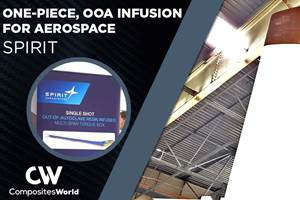What the 787 says about the future
My oldest son is 12. College for him is seven years away, but he’s already thinking about it.
My oldest son is 12. College for him is seven years away, but he’s already thinking about it. Half-jokingly, I suggested he attend the University of Wyoming, study composites materials and manufacturing and then seek a job at Adam Aircraft (we live in Colorado). The future, I said, is bright. This got me to thinking, though: When he finishes college, where in their evolution will aerospace composites be?
A seminal moment in that evolution will come this summer when Boeing rolls out the first 787 Dreamliner — an event that already is generating the kind of hype that guarantees a worldwide audience. It’s easy to see why: Migration from metal to composites in aircraft construction seems, to the uninitiated, an almost radical concept. Even a technically astute layperson can find it difficult to grasp the idea of a resin reinforced with carbon fibers providing structural support in a passenger airplane.
While we in the industry applaud the paradigm shift the Dreamliner represents, it’s clear that the aerospace industry has been headed this way for some time. The use of carbon fiber in the fuselage on a commercial aircraft is new, but it’s only the latest step in a series. In some ways, the use of composites to the extent seen in the 787 was inevitable.
As far back as the mid-1960s, Boeing dabbled with composites use in commercial aircraft. In 1973, Boeing built carbon/epoxy spoilers for the 737. In 1975, Douglas Aircraft built carbon/epoxy upper rudders for the DC-10. In 1980, Boeing made carbon/epoxy elevators for the 727, followed by horizontal stabilizers on two 737s in 1984. In the early ’80s, the 757 and 767 saw carbon/epoxy used in elevators, rudders, spoilers, cowlings and flap track fairings. In the mid ’80s, Airbus used carbon/epoxy in the vertical stabilizer on the A310-300 and in the horizontal stabilizer on the A320. Boeing’s 777 used carbon/epoxy for the vertical tail and horizontal stabilizer. By the ’90s, composites accounted for 10 to 15 percent of a plane’s structural weight. Composites on the A380 weigh in at 33 tons and account for about 16 percent of its airframe weight, making it the most composites-intensive plane to date.
The big evolutionary step with the 787 is the use of carbon/fiber throughout the plane’s structure — fuselage, windows, wing boxes, control surfaces, tail, stabilizers. And we eagerly await the next step as details of composites use are revealed in Airbus’ A350 XWB.
In light of all of this evolution, where will composites use be in the next decade and beyond? Certainly there are lessons being learned even today as the first 787 is assembled. We know Boeing and Airbus (and all aerospace) engineers are constantly discovering new ways of orienting tape and fiber and new ways of using new resins. Where else might composites find use? What role will emerging out-of-autoclave materials and processes play? How fast will automated tape layup machines get? What will tooling be made from? Will nanocomposites find use in commercial aircraft?
The 787 is, in many ways, revolutionary. It represents a thorough departure from a design and materials philosophy that has governed and dominated the commercial aircraft industry for generations. The 787 is not, however, merely a keen technical trick. It’s a major evolutionary adaptation to a variety of external forces: Rising fuel prices, demand for increased aircraft efficiency and the need for enhanced passenger comfort. We’ll watch this evolution with interest and, as usual, keep you posted on its progress.
Related Content
COMPINNOV TP2 project promotes use of thermoplastics in aerospace
Completed in 2023, COMPINNOV TP2 explored thermoplastic composites, enhancing the understanding between prepregs and production methods to foster the potential for French aerospace innovation.
Read MorePEEK vs. PEKK vs. PAEK and continuous compression molding
Suppliers of thermoplastics and carbon fiber chime in regarding PEEK vs. PEKK, and now PAEK, as well as in-situ consolidation — the supply chain for thermoplastic tape composites continues to evolve.
Read MoreVIDEO: One-Piece, OOA Infusion for Aerospace Composites
Tier-1 aerostructures manufacturer Spirit AeroSystems developed an out-of-autoclave (OOA), one-shot resin infusion process to reduce weight, labor and fasteners for a multi-spar aircraft torque box.
Read MoreComposite resins price change report
CW’s running summary of resin price change announcements from major material suppliers that serve the composites manufacturing industry.
Read MoreRead Next
All-recycled, needle-punched nonwoven CFRP slashes carbon footprint of Formula 2 seat
Dallara and Tenowo collaborate to produce a race-ready Formula 2 seat using recycled carbon fiber, reducing CO2 emissions by 97.5% compared to virgin materials.
Read MoreDeveloping bonded composite repair for ships, offshore units
Bureau Veritas and industry partners issue guidelines and pave the way for certification via StrengthBond Offshore project.
Read More“Structured air” TPS safeguards composite structures
Powered by an 85% air/15% pure polyimide aerogel, Blueshift’s novel material system protects structures during transient thermal events from -200°C to beyond 2400°C for rockets, battery boxes and more.
Read More












.jpg;maxWidth=300;quality=90)









